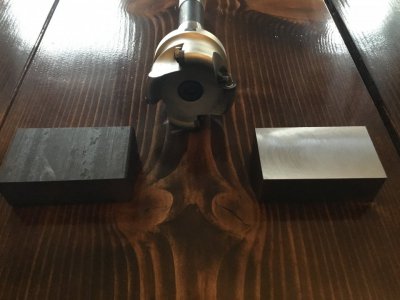Hi All
So pictured below you see to mild steel blocks. The one on the left is cut from my bar stock without anything else done to it. The one on the right is a "finished" blank. Later it will be milled into my guitar bridge.
Stock block
L 2.92"
W 1.668"
H .986"
Finished blank
L 2.79"
W 1.625"
H .955"
My comparison here is a question. How long would it take you pros to turn the block on the left into the finished blank on the right?
I have added into the pic the tool I use to do the above. I get nervous about heavy cuts with these little circular blades on the tool so I only make at most .010" cuts.
I run the tool at 1000 RPM's. (I usually start with .005" cuts until the patina is off then I go to .010" cuts, and I use my x axis powerfeed running slowly.)
When I get within .010" of my final dimension I then go to a .005" pass, then a .003" pass, then .002" pass and finally two .001" passes at double the speed.
My goal with the small cuts is to minimize the depth of the swirls because I do the real finish with hand sanding.
I'll share with you later how long it all takes me. For now I'm curious and I would love to know how long it takes you pros to make the finished blank.
So pictured below you see to mild steel blocks. The one on the left is cut from my bar stock without anything else done to it. The one on the right is a "finished" blank. Later it will be milled into my guitar bridge.
Stock block
L 2.92"
W 1.668"
H .986"
Finished blank
L 2.79"
W 1.625"
H .955"
My comparison here is a question. How long would it take you pros to turn the block on the left into the finished blank on the right?
I have added into the pic the tool I use to do the above. I get nervous about heavy cuts with these little circular blades on the tool so I only make at most .010" cuts.
I run the tool at 1000 RPM's. (I usually start with .005" cuts until the patina is off then I go to .010" cuts, and I use my x axis powerfeed running slowly.)
When I get within .010" of my final dimension I then go to a .005" pass, then a .003" pass, then .002" pass and finally two .001" passes at double the speed.
My goal with the small cuts is to minimize the depth of the swirls because I do the real finish with hand sanding.
I'll share with you later how long it all takes me. For now I'm curious and I would love to know how long it takes you pros to make the finished blank.


